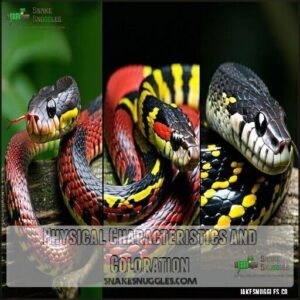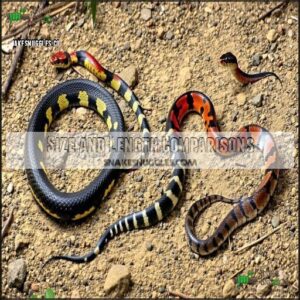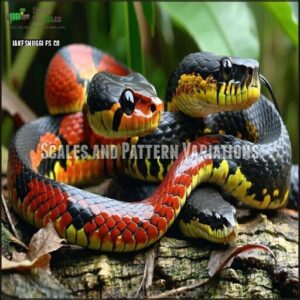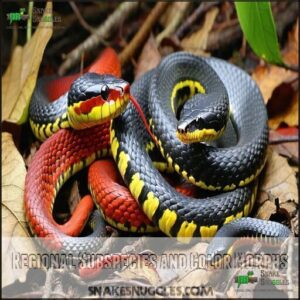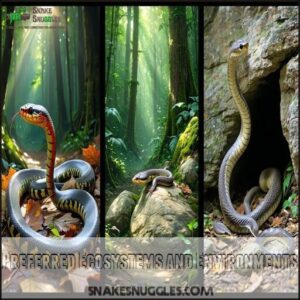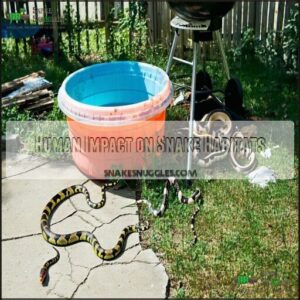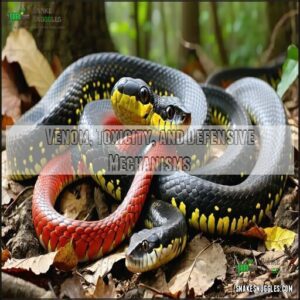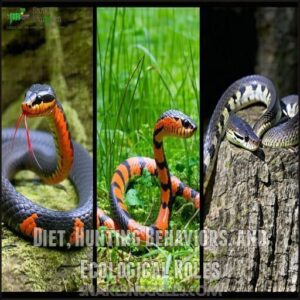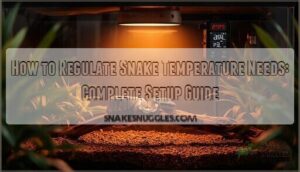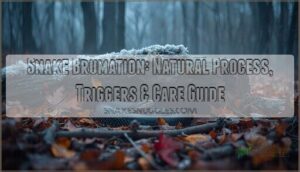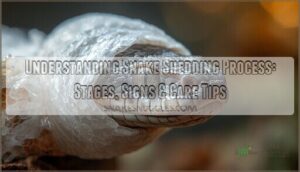This site is supported by our readers. We may earn a commission, at no cost to you, if you purchase through links.

Coral snakes have red bands touching yellow bands ("red touch yellow, kill a fellow"), contain deadly neurotoxic venom, and have rounded heads.
King snakes and milk snakes are harmless mimics with red bands touching black bands ("red touch black, friend of Jack"), constrict prey, and have more angular heads.
While king snakes are larger and eat other snakes, milk snakes are more slender with brighter colors.
Knowing these differences isn’t just fascinating—it could save your life during your next outdoor adventure, and remembering "red touch yellow, kill a fellow" and "red touch black, friend of Jack" can be crucial, as coral snakes contain deadly neurotoxic venom and have distinct rounded heads.
Table Of Contents
- Key Takeaways
- Identifying Coral Snakes, King Snakes, and Milk Snakes
- Habitat and Geographic Distribution
- Venom, Toxicity, and Defensive Mechanisms
- Diet, Hunting Behaviors, and Ecological Roles
- Conservation Status and Human Interactions
- Frequently Asked Questions (FAQs)
- How do you tell the difference between a milk snake and a coral snake?
- What is the difference between a Kingsnake and a milk snake?
- How do you tell a Kingsnake from a coral snake?
- What is the rhyme for the milk snake?
- What is the difference between a kingsnake and a milk snake?
- How can you tell a king snake from a coral snake?
- What is the rhyme for coral snakes and king snakes?
- What is the difference between a kingsnake and a coral snake?
- How can you tell a coral snake from a milk snake?
- How do you tell a milk snake from a coral snake?
- Conclusion
Key Takeaways
- You can identify venomous coral snakes by their distinctive pattern where red bands touch yellow bands—remember "red touch yellow, kill a fellow"—while harmless king and milk snakes have red bands touching black bands.
- You’ll notice coral snakes have rounded heads and deadly neurotoxic venom requiring immediate medical attention, whereas king and milk snakes have more angular heads and use constriction to hunt their prey.
- When you’re in their habitat, recognize that king snakes are larger (up to 6 feet) and eat other snakes, while milk snakes are more slender with brighter colors, though both are beneficial predators that help control rodent populations.
- You’ll find these snakes in different environments—coral snakes prefer moist, warm forests; king snakes adapt to various habitats from deserts to grasslands; and milk snakes favor rocky areas in cooler, temperate zones.
Identifying Coral Snakes, King Snakes, and Milk Snakes
You can easily tell coral snakes, king snakes, and milk snakes apart by paying attention to their color patterns and body shapes.
Learning the rhyme “red touches yellow, kills a fellow” is a helpful way to identify the venomous coral snake.
Physical Characteristics and Coloration
In terms of identifying snakes by their color patterns, paying close attention to the details can mean the difference between safety and danger. Coral snakes, with their famous "red touch yellow" pattern, are venomous. Their smooth, glossy scales and bold red-yellow-black bands completely encircle their bodies, making coral snake identification straightforward if you know what to look for.
King snakes, on the other hand, feature a "red touch black" banding pattern. These non-venomous snakes have slightly less shiny, keeled scales. When comparing king snake vs coral snake differences, this distinction in banding characteristics is key.
Milk snakes are often mistaken for their venomous counterparts. As milk snake look-alikes, they display a similar combination of red, black, and yellow bands. However, their red bands only touch black, not yellow.
- Coral snake: Smooth scales, red-yellow-black bands.
- King and milk snakes: Red-black bands, non-venomous.
Stay safe by remembering: "Red on yellow, deadly fellow. Red on black, venom lack!
Head and Body Shape Differences
Identifying snakes requires attention to their head and body features. Coral snakes have a rounded snake head shape, short snout length, and lack noticeable neck constriction. Their body proportions are slim and of uniform width, with smooth scales.
In contrast, king and milk snakes have narrower heads, longer snouts, and slight neck definition, making their snake species identification easier. A king snake’s robust body stands out with keeled scales, while milk snakes are slender like corals but feature smooth scales.
Pay attention to facial markings and band thickness, as they differ between species. These traits, combined with body and snout length, make differentiating snakes safer and more accurate in the wild.
Size and Length Comparisons
Size can help you distinguish between a coral snake, king snake, and milk snake, but it’s not a guarantee.
Coral snakes are the smallest, averaging 18-20 inches, with few exceeding 3 feet.
On the other hand, king snakes can reach a maximum snake size of 6 feet and usually average 3-4 feet.
Milk snakes sit in the middle, with an average snake length of 2-3 feet and a few growing to 5 feet.
- Regional size differences exist, like larger Honduran milk snakes compared to smaller Eastern milk snakes.
- Juvenile snake size can resemble adults of smaller species.
- Subspecies size variation adds complexity to identification by relying only on snake length.
The complexity of snake size identification is further increased by these factors, making size and species identification challenging without considering other characteristics.
Scales and Pattern Variations
When figuring out snake identities, focus on scale texture and color order.
Coral snakes have smooth, glossy scales with bold red and yellow rings touching.
Smooth, glossy scales with bold red and yellow rings touching—coral snakes are nature’s unmistakable balance of beauty and danger.
King snakes have slightly keeled scales and red and black rings paired.
Milk snakes show flat, small scales with unique variations.
- Smooth scales: Coral snakes, with bright patterns.
- Keeled scales: King snakes, ring pattern shifts slightly.
- Smaller scales: Milk snakes, softer snake band patterns.
Regional Subspecies and Color Morphs
Snake color patterns can vary across regions, making identification interesting yet tricky.
Regional adaptation and genetic diversity often influence subspecies identification and habitat-specific morphs.
- California kingsnakes show striped or banded patterns, depending on their environment.
- Eastern milksnakes have gray bodies with reddish-brown blotches instead of full bands.
- Sinaloan milksnakes boast broad red bands bordered by bold black and yellow.
These color morph variations highlight nature’s creativity but complicate spotting dangerous coral snakes—always double-check patterns for safety.
Remembering that red touches yellow is essential for distinguishing coral snakes.
Habitat and Geographic Distribution
When comparing coral snakes, king snakes, and milk snakes, their habitats and geographic ranges can help you tell them apart.
Each species thrives in specific environments, ranging from forests and grasslands to deserts and rocky areas, which can be considered as complete concepts for identification purposes.
Preferred Ecosystems and Environments
Coral snakes thrive in moist, warm forests, often burrowing in leaf litter or sandy soils.
They require high habitat moisture, preferring tropical areas.
King snakes, on the other hand, are versatile, adapting to deserts, grasslands, and rocky hillsides.
You might spot them basking or hunting, reflecting their adaptable king snake diet.
Milk snakes favor rocky crevices, thriving in cooler, temperate zones.
Their milk snake habitat includes forests and fields, often near human structures, showcasing their flexible use of snake habitats.
Range Overlap and Sympatric Populations
Coral snakes, king snakes, and milk snakes often share overlapping ranges, but they’ve adapted to coexist without constant competition.
They navigate factors like Coexistence Challenges and Resource Competition, relying on distinct preferences.
- Coral Snake Range: Tropical regions like southern Florida
- Milk Snake Range: Vast, from Canada to South America
- Mimicry Effectiveness: Scarlet kingsnakes mimic coral snakes better when sharing territory
- Distribution Factors: Overlaps are seen in the southeastern U.S.
This snake distribution highlights unique interactions and Hybridization Potential.
Adaptations to Specific Habitats
Adapting to their unique environments, these snakes demonstrate incredible survival skills based on habitat preferences and geographic distribution:
- Coral snakes excel in sandy soils, using burrowing abilities to escape extreme heat or cold, displaying remarkable temperature tolerance.
- King snakes thrive with limited water availability, often sheltering under rocks in deserts for moisture retention and predator evasion.
- Milk snakes blend seamlessly with their surroundings, relying on their camouflage effectiveness to avoid predators in rocky areas.
Their abilities also hinge on prey abundance, using specific adaptations to optimize hunting within their niche snake habitat while avoiding threats.
Seasonal Behavior and Migration Patterns
When temperatures drop, coral, king, and milk snakes enter a slowed-down state called brumation, similar to hibernation habits but requiring water.
As temperatures rise in spring, breeding season begins, followed by activity peaks in warm summer months.
Rainfall effects and regional climates influence snake behavior, with certain snake regions seeing more movement during wet periods.
Snake habitat preferences also affect migrations, especially when food supply shifts or habitats become less favorable.
Human Impact on Snake Habitats
When people expand into wild areas, it changes life for snakes like coral, king, and milk snakes.
Urban sprawl and deforestation push these snakes into risky spaces near humans, where survival gets tricky. Pollution effects also poison ecosystems, affecting food and shelter. On top of that, invasive species can steal resources or become predators, adding to the challenges.
Climate change disrupts snake habitat reliability, altering rainfall, temperatures, and the balance they rely on. Snakes in suburban environments often adapt by exploiting artificial structures for shelter.
To protect these snakes, it’s key to preserve their environments through conservation strategies. You can help by practicing snake habitat awareness and avoiding harmful actions like littering or introducing invasive plants.
- Habitat Loss limits suitable living conditions.
- Pollution Effects damage food sources and shelters.
- Invasive Species threaten ecosystems and balance.
Venom, Toxicity, and Defensive Mechanisms
Regarding venom and defenses, coral snakes stand out with their potent neurotoxic venom, while king and milk snakes are entirely non-venomous.
All three species rely on distinct strategies to protect themselves, including mimicry and specific behaviors when threatened.
Coral Snake Venom Composition and Effects
Regarding coral snake venom, you’re dealing with a potent mix of neurotoxins designed to disrupt the nervous system.
These neurotoxin mechanisms can lead to:
- Bite Symptoms: Nausea, muscle weakness, and difficulty speaking.
- Paralysis Onset: Gradual but serious, affecting breathing if untreated.
- Venom Variation: Even a small dose delivers lethal effects.
- Treatment Efficacy: Antivenom helps counteract the fast-acting toxins, but time is critical.
Prompt administration of coral snake antivenom can greatly improve outcomes.
Snake venom effects can escalate quickly, so medical help is a must after any bite!
Non-venomous Nature of King and Milk Snakes
King snakes and milk snakes are non-venomous snakes, making them harmless to humans when handled carefully.
These snakes rely on constriction methods to hunt their prey, like rodents and eggs.
Unlike their venomous coral snake counterparts, they pose no bite risks.
What’s fascinating is their use of snake mimicry, as their bright patterns resemble coral snakes, confusing predators and providing them with mimicry benefits.
You can even find products related to keeping these snakes.
Here’s a quick comparison:
| Feature | King Snake | Milk Snake |
|---|---|---|
| Venom | Non-venomous | Non-venomous |
| Hunting Strategy | Constriction | Constriction |
| Defensive Behaviors | Snake mimicry | Mimicry benefits |
Milk snakes, king snakes, and their look-alikes play essential roles in ecosystems by controlling pests through their feeding habits.
Mimicry as a Defensive Strategy
Milk snakes are experts at Batesian mimicry, imitating the red, black, and yellow bands of coral snakes to fool predators.
Nature’s greatest illusionists, milk snakes borrow danger’s colors without its bite—fooling predators through perfect deception.
This snake mimicry evolved under strong evolutionary pressures, increasing predator avoidance.
Milk snake color variations are popular.
Here’s how milk snake look alikes benefit:
- Confuse attackers expecting venomous bites.
- Exploit Mullerian mimicry similarities.
- Enhance survival through mimicry effectiveness.
- Adapt to variations in regional predator threats.
Behavioral Responses to Threats
When snakes sense danger, they rely on clever snake defense mechanisms to protect themselves. Coral snakes, scarlet kings, and milk snakes are experts at avoiding conflicts.
Their behaviors range from freezing to blend into surroundings—a classic evasive tactic—to mimicking deadlier species. Some adopt behaviors that amplify their mimicry effectiveness, like tail shaking to resemble rattlesnakes.
Others puff up, looking bigger and less vulnerable, or coil tightly to guard their heads. Hissing, often viewed as aggression, is another signal to back off.
Well-timed snake threat assessment helps them avoid unnecessary aggression. Recognizing these actions enhances snake behavior recognition and teaches respect for nature.
- Tail shaking imitates rattlers
- Puffing up adds size
- Freezing relies on camouflage
- Coiling protects sensitive spots
First Aid and Medical Treatment for Bites
If a snake bite happens, act quickly to minimize harm.
Stay calm and follow these steps:
- Call 911 immediately and describe the snake, if possible.
- Keep the bite below heart level to slow venom effects.
- Wash with soap and water, then cover with a sterile bandage.
Avoid common mistakes like using a tourniquet, applying ice, or trying to suck venom out.
Bite symptoms can include swelling, redness, and breathing problems.
Medical intervention, such as antivenom or supportive treatment, is essential.
Always prioritize professional snake bite treatment for full recovery.
Diet, Hunting Behaviors, and Ecological Roles
You’ll notice that coral snakes, king snakes, and milk snakes hunt differently based on their prey preferences and physical traits.
Understanding their diets and roles in ecosystems helps explain how they control pests and interact with other predators, highlighting their importance in the ecosystem with their unique roles.
Prey Preferences and Feeding Habits
Dietary adaptations define how these snakes thrive. Coral snakes rely on potent venom to hunt smaller creatures like lizards and frogs. They stick to a particular menu, showcasing their specialized prey selection.
King snakes, on the other hand, are versatile snake eaters and experts in ophiophagy, consuming other snakes, rodents, and bird eggs. Milk snakes opt for a generalist approach, adding birds, eggs, and rodents to their diet, demonstrating broad feeding habits.
Here’s a quick comparison:
| Snake | Primary Prey | Hunting Method | Feeding Frequency |
|---|---|---|---|
| Coral Snake | Frogs, lizards, snakes | Venom | Infrequent |
| King Snake | Snakes, rodents, eggs | Constriction | Moderate |
| Milk Snake | Birds, rodents, eggs | Constriction | Variable |
| Juveniles (All) | Smaller prey types | Depends on species | More frequent |
These feeding habits highlight their ecological roles in controlling pest and rodent populations.
Hunting Techniques and Adaptations
Hunting requires specialized tools and behaviors, and coral snakes, king snakes, and milk snakes excel in their unique approaches to catching prey.
Their dietary adaptations guarantee success across diverse environments.
- Coral snakes rely on venom delivery, injecting neurotoxins through small fangs to paralyze prey like lizards or smaller snakes.
- King snakes use a powerful snake constriction method, coiling tightly around rodents or other animals until they’re subdued.
- Milk snakes also crush prey with constriction strength, making them versatile predators.
These snake hunting strategies include sharp prey detection skills, with highly sensitive senses for spotting movement—especially at night.
Their natural ambush tactics allow them to blend in, facilitating swift, efficient captures.
Role in Controlling Rodent Populations
While hunters demonstrate their techniques, they also serve a greater purpose in your local environment.
King snakes and milk snakes act as natural rodent control specialists, keeping mouse and rat populations in check.
You’ll find these beneficial predators consuming anywhere from 10-20% of local rodent populations annually.
This ecosystem balance isn’t just good for nature—it directly impacts agricultural success by reducing crop damage.
Farmers often welcome these non-venomous species for their role in prey population management.
Unlike their cousins, coral snakes rarely target rodents, focusing instead on smaller reptiles, leaving the important rodent control work to king and milk snakes, which play a crucial role in maintaining the ecosystem balance and supporting local environment needs.
Interactions With Other Predators
Beyond their role as rodent controllers, these snakes have unique relationships with their own predators.
When threatened, coral snakes rely on their potent venom for predator avoidance. King snakes are bolder, actually hunting and eating other snakes—even venomous ones—using their powerful constriction. Milk snakes benefit from mimicry, confusing predators with their coral-like patterns.
- Snake predators include hawks, owls, and larger mammals
- Each species utilizes different defense strategies when confronted
- Ecosystem balance allows these snakes to coexist despite overlapping territories
Impact on Local Ecosystems
These three snake species serve as essential ecosystem engineers through their unique predator-prey dynamics.
You’ll notice their substantial biodiversity influence across various habitats:
- Coral snakes regulate lizard populations, maintaining ecological balance in reptile communities
- King snakes control rodent numbers, preventing habitat degradation and protecting vegetation from overgrazing
- Milk snakes manage multiple prey species across diverse ecosystems, supporting overall ecosystem health
When snake populations decline, prey species often surge unchecked, disrupting the delicate balance of local food webs.
This ripple effect demonstrates how these slithering predators, despite their fearsome reputation, actually contribute substantially to preserving biodiversity in their environments.
Some species, like swamp snakes, exhibit adaptations for aquatic environments, which is a key factor in their ability to thrive in diverse ecosystems and maintain the balance of their environments, thus playing a crucial role in ecological balance.
Conservation Status and Human Interactions
You’ll find that coral, king, and milk snakes face different conservation challenges today, with habitat loss and road mortality affecting their populations across North America.
Understanding these issues can help you make informed decisions about snake encounters on your property, whether you’re considering safe relocation methods or learning about local conservation efforts that protect these important predators.
Threats to Snake Populations
Coral snakes, king snakes, and milk snakes face multiple threats in their natural environments.
Habitat loss from urbanization and agriculture destroys their homes, while climate change alters their activity patterns.
Invasive fire ants prey on eggs and juveniles, substantially reducing population numbers.
Human persecution due to misidentification or fear leads to unnecessary killings.
Roads create deadly barriers, causing high mortality rates.
Pollution impacts their food sources, while overcollection for the pet trade diminishes wild populations.
These combined pressures create serious conservation challenges for all three species, threatening their long-term survival, due to habitat loss, human persecution, and other factors like invasive species and pollution.
Conservation Efforts and Protected Status
While habitat destruction threatens many snake species, conservation efforts are gaining momentum to protect these valuable reptiles.
Federal and state legal protections now safeguard coral snakes in several regions, while population monitoring programs track king and milk snake numbers with precision.
Conservation groups have established these critical initiatives:
- Habitat preservation zones connecting fragmented landscapes where snakes can thrive
- Regular scientific surveys documenting population trends and genetic diversity
- Community education workshops that reduce fear and promote peaceful coexistence
- Specialized breeding programs maintaining healthy genetic diversity
Conservation genetics research has revealed that some snake populations have unique adaptations to their local environments.
The venom of some species, like the Mojave’s neurotoxic compounds, poses a significant threat if not treated promptly.
Scientists use this data to prioritize protection for areas with high biodiversity value, ensuring these distinctive reptiles remain part of our ecosystem for generations to come, thanks to conservation efforts and precise monitoring.
Snakes in Captivity and Pet Trade
Unlike coral snakes, king and milk snakes make excellent pet choices with proper care.
These Lampropeltis species require specific husbandry needs to address captivity challenges.
You’ll need temperature-controlled enclosures with warm sides (85-88°F) and cool sides (75-80°F) to mimic their natural behavior as crepuscular creatures.
Always choose captive-bred specimens for ethical considerations and conservation impact.
Wild collection faces legal restrictions in states like California and Arizona.
Aspect King Snakes Milk Snakes Ethical Tips
Diet
Habitat
Legal Restrictions
Breeding
King snakes need at least a 4’×2’×2′ enclosure while milk snakes require 3’×2’×2′ minimum – a common pet care mistake is thinking "too big" stresses them.
Education and Public Awareness Programs
Education programs turn fear into understanding regarding snakes.
While captive breeding satisfies collectors, public awareness remains key to snake conservation.
Snake identification workshops help you confidently distinguish between venomous coral snakes and harmless lookalikes.
Many community outreach initiatives now focus on debunking common snake myths through hands-on learning.
Access these resources for better snake awareness:
- Visit nature centers offering snake safety tips and live identification demonstrations
- Download mobile apps that use AI to help with snake identification in your area
- Participate in conservation education events where experts explain snake behavior and habitat protection
These programs create safer communities where humans and snakes coexist through knowledge rather than fear – no snake hook required!
Coexistence Strategies for Humans and Snakes
Living alongside snakes requires simple, practical steps for mutual safety. Create snake-resistant yards by removing debris piles and maintaining short grass—this Safe Landscaping discourages unwanted visitors.
Seal foundation cracks and install mesh fencing as effective snake precautions. When encountering these reptiles, stay calm and back away slowly; remember your snake safety guidelines: never attempt handling unknown species.
Professional Snake Relocation services can safely remove unwanted guests without harm. Support Education Initiatives in your community to reduce unnecessary fear and promote Responsible Development that respects natural habitats.
Keep snake safety tips accessible for family members, including storing emergency numbers and learning basic identification patterns. The Coexistence Benefits are clear—healthy ecosystems with natural pest control and reduced human-wildlife conflicts.
Frequently Asked Questions (FAQs)
How do you tell the difference between a milk snake and a coral snake?
The colors tell the tale – remember "red touches yellow, kills a fellow."
You’ll notice coral snakes have red and yellow bands touching, while milk snakes have black bands separating them.
Check their faces too.
What is the difference between a Kingsnake and a milk snake?
Kingsnakes and milk snakes both belong to the same genus but differ in size and pattern.
You’ll notice kingsnakes can grow larger (up to 6 feet) while milk snakes typically stay under 3 feet with more distinctive blotches.
How do you tell a Kingsnake from a coral snake?
Remember the rhyme: "Red touches yellow, kills a fellow. Red touches black, friend of Jack."
You’ll notice coral snakes have red and yellow bands touching, while kingsnakes have red and black bands touching.
What is the rhyme for the milk snake?
For milk snakes, you’ll want to remember: "Red touches black, you’re okay Jack".
This helps you identify these harmless snakes where red bands touch black bands, not yellow ones like venomous coral snakes.
What is the difference between a kingsnake and a milk snake?
You can easily distinguish between these two non-venomous snakes by their patterns.
Kingsnakes typically have complete bands around their bodies, while milk snakes often display blotches instead of bands and are generally smaller.
How can you tell a king snake from a coral snake?
Imagine you’re hiking and spot a striped snake.
You can tell them apart by their patterns: "Red touches yellow, kills a fellow. Red touches black, friend of Jack."
King snakes have red bands touching black bands.
What is the rhyme for coral snakes and king snakes?
The traditional rhyme for identifying these snakes is: "Red touches yellow, kills a fellow.
Red touches black, friend of Jack."
This helps you remember that coral snakes have red and yellow bands touching, while king snakes don’t.
What is the difference between a kingsnake and a coral snake?
Life or death lies in the bands: coral snakes have red touching yellow ("kills a fellow"), while kingsnakes have red touching black ("friend of Jack").
Coral snakes are venomous; kingsnakes aren’t.
Check the head color too!
How can you tell a coral snake from a milk snake?
You can spot a coral snake by its red and yellow bands touching ("red touches yellow, kills a fellow").
Coral snakes also have black heads with yellow bands below, which is a distinguishing feature.
Milk snakes have black bands separating red and yellow, making them distinct from coral snakes with red and yellow bands and a black head.
How do you tell a milk snake from a coral snake?
You’d think red stripes are all the same, but they’re not.
Check band patterns: red touching yellow means coral snake (dangerous), while red touching black indicates milk snake (harmless).
Remember: "Red touches yellow, kills a fellow" is a key phrase to keep in mind when differentiating between these snakes.
Conclusion
Remember, distinguish coral snake vs king snake vs milk snake with their distinctive ring patterns.
You’ll stay safe by memorizing "red touch yellow, kill a fellow" for venomous coral snakes and "red touch black, friend of Jack" for harmless mimics.
When you’re outdoors, take a moment to observe head shape, size, and behavior too, and with these identification skills in your nature toolkit, you’ll confidently enjoy wildlife encounters while keeping yourself and these remarkable reptiles protected, using your newfound skills to stay safe and appreciate the wildlife encounters.
- https://www.wikihow.com/Tell-the-Difference-Between-a-Milk-Snake-and-a-Coral-Snake
- https://a-z-animals.com/animals/comparison/coral-snake-vs-milk-snake/
- https://www.reddit.com/r/snakes/comments/ylha08/how_to_differentiate_between_milkshakes_scarlet/
- https://animals.howstuffworks.com/snakes/coral-snake-vs-king-snake.htm
- https://coastalbg.uga.edu/2023/10/the-colubrid-trio-coral-snake-vs-scarlet-king-snake-vs-scarlet-snake-with-a-milk-snake-twist/

